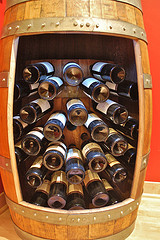Wine Racks: the Perfect "Two-Way" Repurpose
 Repurposing has been gathering steam over the past few years as a fun and inexpensive way to reduce our landfills and help save the planet. Lately we've started seeing lots of examples of a popular "two-way" repurpose. Wine racks are transformed into household accessories such as towel hangers or vertical gardening stands, while anything from an old dresser found by the roadside to an antique cask can be upcycled as a uniquely inventive wine rack.
Repurposing has been gathering steam over the past few years as a fun and inexpensive way to reduce our landfills and help save the planet. Lately we've started seeing lots of examples of a popular "two-way" repurpose. Wine racks are transformed into household accessories such as towel hangers or vertical gardening stands, while anything from an old dresser found by the roadside to an antique cask can be upcycled as a uniquely inventive wine rack.
Quirky Repurposes for Vintage Wine Racks
After hunting down vintage wine racks in thrift shops, at garage sales, or even abandoned next to garbage bins, creative and quirky repurposers use their finds to craft all kinds of pretty, practical storage. Some of our favorites are wooden accordion types or intricate wrought iron racks, which strut their stylish stuff in shabby chic bathrooms as guest towel holders. They also appear in well-stocked craft rooms as shelves for the ever-popular mason jars -- filled with essential notions like buttons and bows -- or as handy ribbon or cord dispensers. Wine racks are fantastic as organizers for rolls of gift wrap, glossy home decorating magazines, costume jewelry, or an overabundance of charger cords. Out in the garden, these convenient storage solutions can become vertical gardening stands for small-scale plants.
Wine Racks Made From What??
Moving in the other direction, the sky's the limit as wine racks are created from the most unusual objects. Wh would have thought of stacking wine bottles in the crevices of a set of stripped mattress springs? An artistic and adept upcycler, that's who. In case you don't have access to a nearby supply of discarded mattresses -- or you're dealing with a smaller stash of wine, you can make use of old tools (bent at an appropriate angle) or lengths of PVC pipe, repurposed as ingenious, attractive bottle holders. We especially enjoy the many wine cabinets recycled from major pieces, such as venerable dressers, over-the-hill musical instruments, or elderly steamer trunks and suitcases. The essential guiding principles here are to make sure that racks are sturdy enough to support the weight of full bottles (at about 3 pounds each, including contents) and that your fine wine will be stored under the right conditions to preserve its high quality.
Tips For Successful Wine Storage
Recently we spotted a wine shelf built into the niche between a dishwasher and the kitchen wall. While this project gets top marks for space saving, wine connoisseurs would rank it a dismal fail, since it violates several of the most basic conditions for optimal wine storage:
1. Provide a climate of 55-60 F. High temperatures can "cook" fine wine, while at lower temperatures, the wine won't mature properly … and may run the risk of freezing. Avoid abrupt temperature changes, which will cause rapid expansion and contraction, to keep wine at its best.
2. Make sure the atmosphere is sufficiently humid, approximately 75 percent humidity for best results. Keep wines at a distance from your HVAC registers, where the air tends to be excessively dry.
3. Provide adequate air circulation. Lack of circulation can cause mold or transference of ambient odors to the wine. Make sure that there is sufficient space around your bottle and use a fan to enhance air movement, if necessary.
4. Keep your wine quiet. Avoid vibration or any unnecessary movement around sensitive vintages.
5. Safeguard against excessive light. There is a reason why so many wine bottles are green rather than colorless. Protection from UV rays, whether from the sun or from artificial sources, is important in maintaining quality.
6. Ensure your storage is clean. Termites, scorpions, and other undesirable insects breed in rotted wood or moist potting soil, especially in humid Pacific Coast weather, so as the best form of Seattle pest control, watch for signs of decay in wooden racks and do not accessorize the area with houseplants.
Laura Firszt writes for networx.com.
Looking for a Pro? Call us (866) 441-6648

Pest control Average Costs
Exterminators Experiences

Roof Repair To Keep Out Miami Rainstorms

Ceiling Fan Replacement By A Fast, Knowledgeable And Reasonable Electrician



